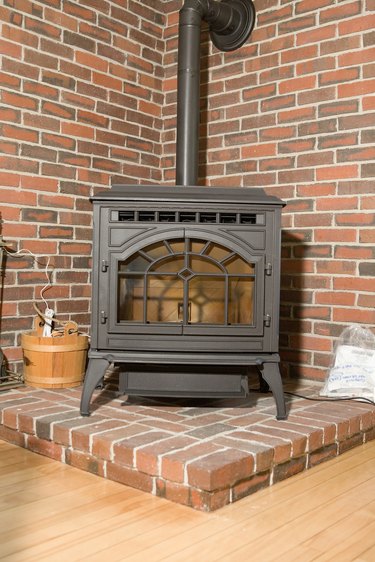
Wood stoves work by way of a natural draft system that pulls combustible air in from the room and vents it through a flue pipe that carries the warm air up the chimney and to the outside. If the air flow is blocked, whether by a physical narrowing of the flue or because depressurization near the stove leads to air being forced out of the stove instead of drawn in, the result is a downdraft, or backdraft, that pours smoke and noxious fumes into the room. Reversing the downdraft requires eliminating blockages and restoring proper airflow.
Step 1
Schedule to have your chimney serviced to remove creosote buildup as well as birds' nests and other objects that might block air flow.
Video of the Day
Step 2
Check your flue for negative-pressure issues. Place your hand in the unlit stove, near the open damper. You may feel a cold draft blow against your hand if the room has negative pressure.
Step 3
Inspect the gasket on your stove door to make sure the door is as airtight as possible. Repair or replace the gasket, if necessary.
Step 4
Evaluate the entire length of flue pipe to make sure it's in good repair. Repair or replace damaged sections of pipe.
Step 5
Light a piece of newspaper on fire and hold it in the same place where you held your hand. Negative pressure extinguishes the flame or blows the flame into the stove instead of drawing it into the flue.
Step 6
Reverse the downdraft by increasing the air pressure in the room with the wood stove. Open a window before you light the fire. Turn off appliances with fans that draw air out of the house, including the clothes dryer, kitchen range hood and bathroom fans.
Step 7
Stabilize low air pressure caused by differences between indoor and outdoor temperatures by warming the flue with a lit piece of paper before you light the stove. Hold the paper near the flue, from inside the stove.
Step 8
Install a residential ventilation system, or upgrade an existing system, as a permanent solution.
Tip
Install a carbon monoxide detector in every room with a combustible heat source.
Warning
Never vent a wood stove into a chimney already in use by another stove or a fireplace. Each wood burning appliance needs its own.
Don't allow your wood stove to draw combustible air from a garage or from another room that uses a combustible heat source. A downdraft may pull carbon monoxide from one space into the other.
Video of the Day